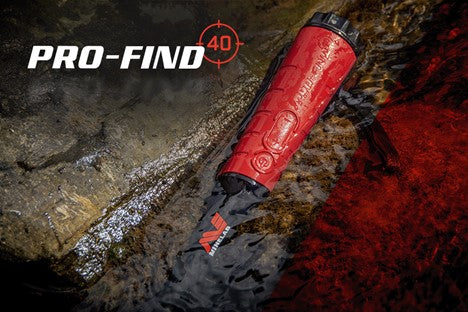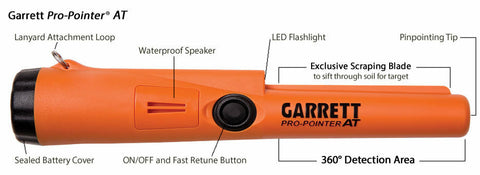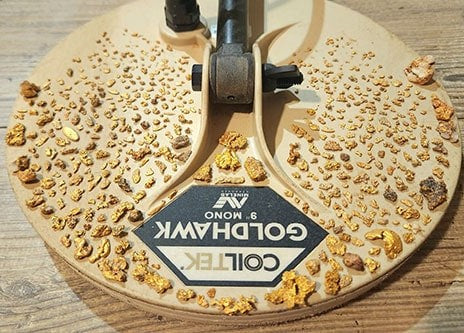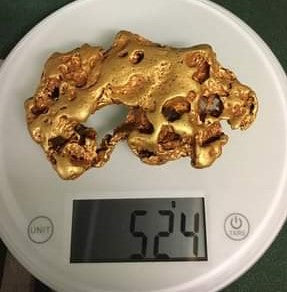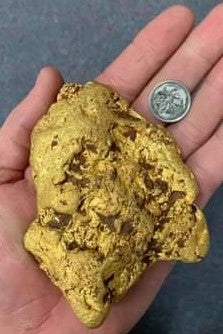TIPS FOR GOLD HUNTING IN WESTERN AUSTRALIA – Part 2 of 3
To prospect safely alone in W.A., particularly when I was solo free ranging (i.e. patch hunting on my own) and some days walking up to 8km away from my 4WD, I always carried a fair bit of gear on my body, for both practical & safety reasons.
Accordingly, I used a very comfortable load bearing, mesh-style vest (featuring a rear backpack and many pouches). It typically hit the scales at about 12kg (much heavier than my Minelab pulse-induction detectors + big pick). I would always carry at least 5 litres of water, 3 days of food rations, first-aid kit, LED headlamp, LED torch including strobe light, a PLB, an extra GPS device (apart from the Trilobite App on my phone), spare batteries, Gorilla tape, cable ties, cigarette lighter, a LifeStraw water filter, Leatherman tool, etc.
Another option for carrying less gear (including detecting closer to your vehicle) is to use a harness.
It pays to carry more-than-sufficient water – both on foot, and in your vehicle. Many people who perished in remote areas in recent years did so away from their vehicles and also without water. (e.g. many people forget, or simply do not consider, that the windscreen washer water reservoir within the engine bay of most 4WD vehicles can contain at least a few litres of pure water – that can possibly be drinkable, as an absolute last resort in the event of an emergency. I do not add any chemicals to my water reservoir, and regularly flush & refill it with clean and pure water, for that very reason. Who knows …. Something so simple could save a life one day).
If you are intending to prospect alone in remote areas, it is also important to consider issues like:
Reliability and maintenance of your vehicle
Carrying suitable & sufficient water, food, safety equipment, fuel, and spare parts, and allowing for potentially being stranded for many days
Communications equipment
Weather forecasts
Spare metal detector/s and batteries and cables and coils
Spare key for vehicle – not locked inside the vehicle
Charging of batteries (e.g. via deep-cycle battery and/or solar or generator)
DOUBLE-RECORD THE LOCATIONS OF YOUR VEHICLE & CAMP
In recent years, several prospectors (mostly older blokes) have gone missing in W.A. Despite extensive searches, some missing prospectors have not been found, nor any of their prospecting gear. This makes you wonder – fools play? or foul play?
One valuable lesson I learned was to double-record the co-ordinates of the locations of my parked 4WD and camp. I would record the GPS co-ordinates on both my Trilobite App, and on my back-up Garmin GPS device (just in case one of them ever failed). This method served me well, especially in terrain which was new to me, or where the vegetation was all the same, and in the absence of nearby landmarks.
PERSONAL LOCATOR BEACONS (PLB’s) / EPIRB’s
Did you know?
That some PLB/EPIRB devices have been activated unintentionally by being too close to the coil of a pulse-induction metal detector that is turned on/operating.
In 2017 a prospector in the Pilbara, Western Australia - who reportedly had possession of a Personal Locator Beacon (PLB) - unknowingly had his 'KTI' brand SA2G model PLB activated - when it came within very close proximity of the operating coil of his pulse-induction metal detector.
(Also reported on the Facebook page of "Finders Keepers Gold Prospecting" – refer to posts on 5 October 2020).
I understand that due to this issue - KTI re-designed their SA2G model PLB - which is now designated as the SA2GN model.
There have also been other similar accidental activations of EPIRB/PLB's by operating pulse-induction metal detectors being placed too close.
There are in excess of fifty (50) different models of EPIRB's/PLB's available on the Australian market. 'KTI' is one of the most popular brands of PLB.
To avoid the potential for accidental activation of my PLB – I keep my PLB (inside the rear of my backpack) and stored inside a waterproof, stainless-steel canister – which acts as a ‘Faraday Shield’ – to block electromagnetic fields/radiation.
PLB/EPIRB TESTING + AMSA RECORD
Given that most of my prospecting was alone in W.A, and often in remote areas, I ALWAYS carried a PLB/EPIRB.
Not only that, I also REGULARLY tested (before every trip away or every 2 months - whichever came sooner) that my PLB was in proper working order. This included testing that the battery life was OK, and also that the transmitter function of the device also worked correctly - via the Manufacturer's recommended Test Mode functions on the device.
After this was done, I would also update my AMSA Registration record (via my online account), including information about my planned pending trip, re: my vehicle/s, planned trip route, likely camping locations & estimated travel dates.
HARD GROUND = HARD WORK BY HAND
Some of the hardest ground I have encountered during prospecting is in W.A. I soon learned the importance of using a high-quality, heavy-duty pick. In some locations I found gold within/near Calcrete (a natural, concrete-like formation). Gold is often associated with the presence of Calcrete, and also with the presence of ironstone and quartz (particularly "rotten" quartz). In some instances where I detected gold contained within Calcrete, I used a cold-chisel & steel mallet, or a heavy-duty crowbar & sledgehammer (stored within my 4WD) to free the gold nuggets from calcrete.
Quality gloves are also useful to prevent blisters, abrasions, cuts, sunburn and hot ground.
On some hot summer days, the ironstone-pebble strewn ground got so hot that I was unable to hold by bare hands upon the ground for longer than about 3 seconds before burning my palms. Knee pads (including incorporated into work trousers) can also be very useful – some days I would dig & backfill over a hundred holes – which really worked my knees & back.
POTENTIAL THREATS
After spending years living, working and prospecting in the bush throughout Australia – not too much worries me out there in the bush.
I have had many solo encounters with lone wild dogs, and they all appeared to be very cautious of my presence. During the several encounters I have had with a pack of wild dogs, I was more concerned as they seemed less scared of me and more prone to come closer to me as a pack, before I scared them off.
My advice – Be aware of your surroundings (“situational awareness”), particularly if you are alone. Accordingly, I prefer to mostly use speakers when detecting, or sometimes a sports earphone in one ear (not earmuffs-style headphones). Noise is a generally good deterrent against wild animals, including wild dogs. Interestingly, I read that scientists from two Queensland universities recently found that some Australian snakes such as Taipans, brown snakes and death adders can hear, as well as sense vibrations.
JOE BLAKES & SPINIFEX
Leg gaiters – for protection against both “Joe Blakes” (snakes), and also Spinifex needles (common throughout Western Australia’s goldfields). Over the past 7 years I have been wearing gaiters (‘SNAKEprotex’) – that were rated for protection against venomous Australian snakes (including an adult Taipan which can possess fangs up to one-half-an-inch long). I found gaiters excellent for protection against spinifex needles when I was gold prospecting in both central Australia and Western Australia. Lots of good gold country in W.A. often contains plenty of spinifex.
PROSPECTING AT NIGHT
Unless you have significant local prospecting experience, you would be taking big risks to prospect alone in W.A. at night in terrain you are not very familiar with. Many biting/stinging creep-crawlies come out at night. It is also much more challenging to judge the distance of range at night.
I only ever prospected alone at night upon pushed/scraped gold patches (well-defined areas) nearby where my vehicle was parked, with an LED strobe light operating upon the roof-rack (as a great reference point marker). A spare headlamp + spare batteries are a MUST.
PERFORMANCE ENHANCING
Be mindful of your personal performance when prospecting alone. A few things that I found affected my prospecting performance were not keeping properly hydrated, lack of regular meals & breaks, poor boot comfort, and poor ergonomics of backpack & detector.
Also be mindful of issues that may affect the performance of/interfere with your super-sensitive, pulse-induction metal detector e.g. mobile phones NOT set on Flight Mode, or wearing steel-capped boots, or UHF radios, or pin-pointers, or the digging pick head too close to your big coil,
FLIES & HEAD-WEAR
During my most recent prospecting travels over the past 7 years throughout most of our awesome continent of Australia, I had not encountered such numbers of menacing flies as I found several hundred kilometres north of Kalgoorlie. From sunrise to sunset, during my regular 8-hour-days of swinging a gold-hunting “beepstick”, the small, fast flies were absolutely relentless.
Annoyance-reduction measures that helped me somewhat included either wearing a head-net (which I generally do not like), or mostly wearing a broad-brimmed, shady hat with a Scrim mesh material curtain draped around the sides & rear (to also provide sun protection), and wrap sunglasses with large lenses. To some degree, I also found that dabbing a suitable repellent (I preferred to use a non-DEET/natural oils-based solution such as Nature’s Botanical Rosemary & Cedarwood Oils Repellent) on my face and the Scrim mesh also deterred many flies. Beware that DEET-based repellents can damage plastics - including the screens of detectors, particularly if the screens do not have a protective cover.
Unfortunately, some of the best gold country I encountered in W.A. also had the worst masses of flies.
HOT ROCKS & METEORITES
During more than 300 days of prospecting in W.A. I reckon I detected hundreds of hot rocks. Moreso with my Minelab SDC2300 than with my GPX 5000 and GPX 6000, and GPZ 7000. Having a curious mind, I always pocketed these highly mineralised/often heavy/often magnetic rocks to take home and smash up in a dolly pot. Occasionally a small bit of gold was won from such hot rocks.
Sometimes such “hot rocks” are in fact of extra-terrestrial origin e.g. meteorites, some of which contain iron, nickel and cobalt. Not all meteorites are attracted to a magnet. Iron-Nickel meteorites (with a majority content of iron, and up to about 8% nickel content) will very strongly attach to a magnet, and hence be clearly detected by a metal detector. Several different types of meteorites have been found in the goldfields of Western Australia, including near Kalgoorlie. Some of the rarest types of meteorites are worth more than gold per ounce.
TRASH
Many prospectors I met have a strong magnet attached to the outer top of their pick head. In trashy areas, a good magnet can pull out a lot of ferrous junk metals (including tiny bits of wire that can cause a lot of wasted time to find otherwise)
I heard similar stories from other prospectors, and I experienced it myself – the detection of aluminium beer/soft-drink cans down deep inside goanna holes, and concealed inside nearby logs. Talk about a frustrating waste of time. So beware of animal tunnel entrance holes, or hollow logs, nearby where you detect a target.
BIG NUGGETS RECENTLY FOUND IN W.A.
In recent years many impressive gold nuggets (and gold/quartz and gold-ironstone specimens) have been unearthed using Minelab pulse-induction-technology metal detectors in Western Australia, including near Kalgoorlie.

(Images source - Facebook page of Finders Keepers Gold Prospecting - Kalgoorlie, W.A.)
OTHER THAN GOLD
Some other interesting things found by prospectors in W.A. include:
Fulgurite (I found a 3.9kg specimen), Opal – including Moss Opal, Chrysoprase (“Australian Jade”), Devils Dice, Meteorites, Australites (Tektites), stone tools, black octahedral Hematite crystals, metallic fragments of SkyLab, gold sovereign/half-sovereign coins, etc.
Other useful tips will be discussed soon in Part 3 of this article – to be published online soon.




















